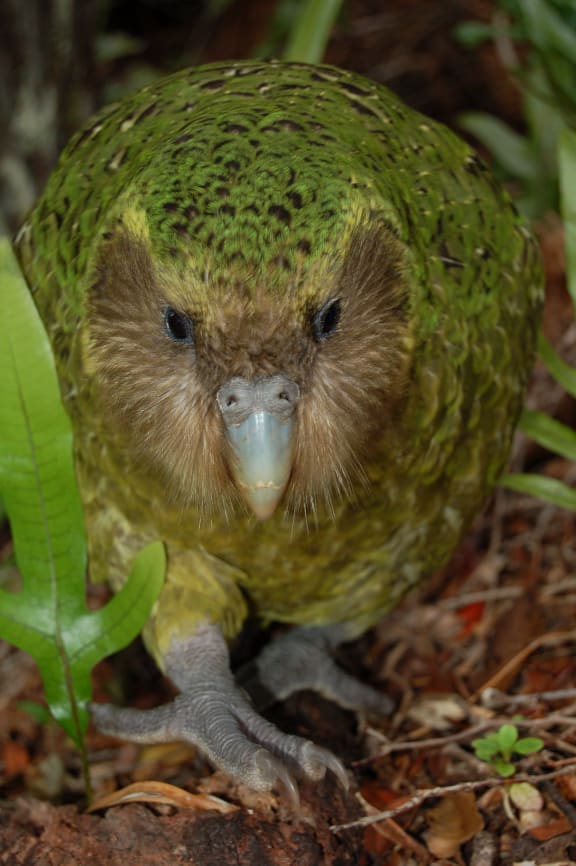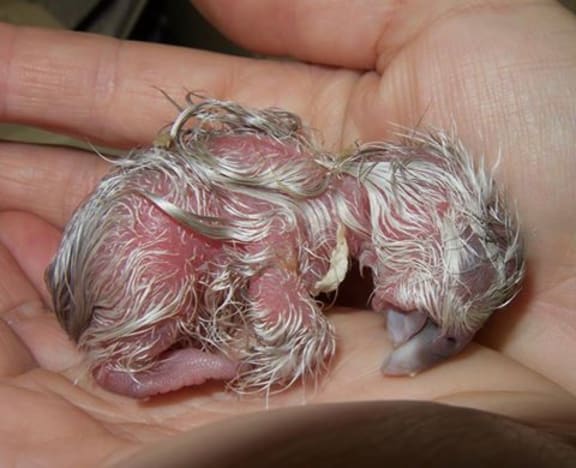Conservationists and geneticists have embarked on an ambitious programme to sequence the genomes of all 123 living adult kakapo – and crowd-funding looks set to make it possible.
This will be the first time in the world that an entire population of animals has had its genomes sequenced.

Sirocco is one just 125 living kakapo, all of whom will have their genomes sequenced this year. This will be the first time a whole population has had its genomes sequenced. Photo: DOC
Scientists are just completing the first complete genome sequence for the endangered flightless parrot. The first genome, of a female called Jane, has been sequenced by Jason Howard and his team at Duke University in the United States.
The remaining genomes will be sequenced in New Zealand by New Zealand Genomics Ltd at the University of Otago.
Dream come true
Dr Andrew Digby, scientist for the Kakapo and Takahe Recovery Programmes, says sequencing the genomes of all kakapo has been a dream for him.
“I thought if we’ve done it for one kakapo, there’s not many living kakapo so could we do it for all of them?”
Kakapo are very inbred and have little genetic diversity. Three birds have rare Fiordland genes and are genetically distinct, but the remaining 120 birds are all descended from a population on Stewart Island that went through a severe genetic bottleneck.
“The questions we can answer will be limited only by our imagination,” says molecular ecologist Associate Professor Bruce Robertson, from the University of Otago.
“As with the human genome project, we’ll be mining this for many years to come, and new and novel things will come out of it.”
What a kakapo genome can tell us
Dr Digby says the kakapo genomes will be useful in many ways, and genetic management of the population to try and ensure that close relatives don’t breed is critical. The kakapo genome will provide a much more detailed look at family relationships.
Kakapo have low fertility, and they will be looking to see if there is a genetic basis to the infertility, especially sperm health and egg hatching success.
Dr Digby says they will look at disease as well, and see if there is any genetic susceptibility.
“We already know that the three Fiordland birds have different MHC genes which are associated with disease resistance, and there may be others. Knowing that might help us find out which kakapo will be less susceptible to disease.
Crowd funding
The cost of genome sequencing 123 kakapo is a surprisingly affordable $100,000. Assoc Prof Robertson says this is only because the first sequence is of very high ‘platinum’ quality and will provide a scaffold against which other sequences can be mapped.
Dr Digby says they have turned to crowd funding as the Kakapo Recovery Programme has limited funds, and all its current resources are being put into what is turning out to be an exceptional breeding season on both Whenua Hou/Codfish Island and Anchor Island.
The crowd funding initiative succeeded in raising its $68,000 target before its end of April 2016 deadline, although they are still collecting funds.
The balance of funds will be raised through the Genetic Rescue Foundation, which is selling the right to fund a genome sequence for specific individual kakapo.
The $100,000 price tag and one year time frame for the kakapo genome sequencing project compares to the US$2.7 billion human genome project that began in 1990 and took 13 years to complete.
Kakapo genome sequencing timeframe
High-quality DNA has been collected for the first 40 birds to be sequenced, and the samples are about to be processed. The first 40 are older founder birds from the Stewart Island population.
As well as the conservation benefit, the kakapo genomes will allow researchers to investigate evolutionary relationships between them and other birds.
“By looking at these evolutionary relationships we’ll hopefully be able to shed light on what makes our kakapo so unusual and interesting,” says Assoc Prof Robertson.
In future, having detailed information about particular genes may allow DNA editing.
2016 kakapo breeding season
2016 is the best kakapo breeding season on record. Kakapo breed irregularly, and the last breeding season was two years ago. In the previous best breeding season, in 2009, 33 chicks successfully fledged.
UPDATE 8 APRIL 2016:

Zephyr2 is the final chick to hatch in the 2106 kakapo breeding season, and she brings the number of surviving chicks to 38. Photo: Kakapo & Takahe Recovery Programme / DOC
Forty four female kakapo mated on three islands. They laid a total of 123 eggs (two females mated but did not lay, and two females mated and laid twice.)
Sixty four of the 123 eggs were infertile (52%). There were further losses, either from embryos dying before hatching or young chicks dying.
Thirty eight chicks are alive at the moment, out of 47 that hatched. The last chick to hatch is Zephyr's second chick, which hatched on 8 April.
Kuia, the female with precious Fiordland genes, laid a second clutch of fertile eggs and two of these have hatched. One chick survives from her first clutch and is being fostered on Whenua Hou/Codfish island.
When the breeding season started there were 125 adult kakapo - two have died, bringing the total adult population to 123.

